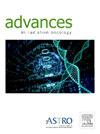磁共振引导在线自适应立体定向身体放射治疗中靶轮廓一致性
IF 2.7
Q3 ONCOLOGY
引用次数: 0
摘要
目的自适应磁共振引导立体定向身体放射治疗(MRgSBRT)需要根据日常解剖快速重新轮廓靶体积。总体肿瘤体积轮廓(GTV)通常由覆盖放射肿瘤学家执行,他们可能比主治医生(PP)更不熟悉病例。本研究的目的是确定PP和覆盖医师(CP)之间GTV轮廓的一致性,并分析资源对支持准确GTV描绘的影响。方法和材料在2021年至2023年期间,59名患者在我们的机构接受了MRgSBRT的302个部分。分析了三种不同类型的轮廓支持资源对GTV的影响:(a)原始GTV的切片数量,(b)外部软件显示原始GTV轮廓,(c) GTV不同时的报警;原价的10%。采用双尾t检验和方差分析,分析不同肿瘤部位和部位的医生和轮廓支持资源之间的差异。结果302例MRgSBRT治疗中有119例(39.4%)由CP监督。在所有治疗组中,PPs(11.1%)与CPs(4.6%)的GTV与原始GTV的平均绝对体积变化百分比差异具有统计学意义(P = 0.00006)。胰腺(12.8% vs 5.0%, P = 0.03)、肝脏(13.0% vs 4.0%, P = 0.007)和淋巴结(12.4% vs 2.1%, P = 0.004)的P体积差异较大。前列腺肿瘤(3.7% vs 3.6%)和肾上腺肿瘤(9.7% vs 12.2%)无显著差异。3种轮廓支撑技术的GTV无显著差异。结论在大多数肿瘤部位,PPs对GTV的影响较大,轮廓支持资源对GTV的影响较小。观察到的差异可能与更熟悉病例的PPs的轮廓置信度较高有关。进一步研究增强轮廓支撑方法是必要的。本文章由计算机程序翻译,如有差异,请以英文原文为准。
Target Contour Consistency During Magnetic Resonance-Guided Online Adaptive Stereotactic Body Radiation Therapy
Purpose
Adaptive magnetic resonance-guided stereotactic body radiation therapy (MRgSBRT) requires expeditious recontouring of target volumes based on daily anatomy. Contouring of the gross tumor volume (GTV) is frequently performed by covering radiation oncologists who may be less familiar with the case than the primary physician (PP). The objective of this study is to determine consistency in GTV contouring between PP and covering physician (CP) and to analyze the effect of resources to support accurate GTV delineation.
Methods and Materials
Between 2021 and 2023, 59 patients underwent 302 fractions of MRgSBRT at our institution. GTVs were analyzed for the effect of 3 different types of contouring support resources: (a) number of slices of the original GTV, (b) external software displaying original GTV contours, and (c) alerting if GTVs differed > 10% from the original. Differences between physicians and contouring support resources were analyzed for different tumor sites and fractions using 2-tailed t test and analysis of variance.
Results
One hundred nineteen out of 302 (39.4%) MRgSBRT treatments were supervised by a CP. The difference in the mean absolute percent volume change of GTV compared with original GTV for PPs (11.1%) versus CPs (4.6%) across all treatment fractions was statistically significant (P = .00006). Significant differences were observed for pancreas (12.8% vs 5.0%, P = .03), liver (13.0% vs 4.0%, P = .007), and lymph nodes (12.4% vs 2.1%, P = .004) with larger volume differences for PPs. No significant differences were observed for tumors of the prostate (3.7% vs 3.6%) and adrenal glands (9.7% vs 12.2%). No significant GTV differences between the 3 contouring support techniques were observed.
Conclusions
Our results show larger GTV changes by PPs for most tumor sites with little impact from contouring support resources. Observed differences might be related to higher contouring confidence of PPs who are more familiar with the case. Further investigation into enhancing contouring support methods is warranted.
求助全文
通过发布文献求助,成功后即可免费获取论文全文。
去求助
来源期刊

Advances in Radiation Oncology
Medicine-Radiology, Nuclear Medicine and Imaging
CiteScore
4.60
自引率
4.30%
发文量
208
审稿时长
98 days
期刊介绍:
The purpose of Advances is to provide information for clinicians who use radiation therapy by publishing: Clinical trial reports and reanalyses. Basic science original reports. Manuscripts examining health services research, comparative and cost effectiveness research, and systematic reviews. Case reports documenting unusual problems and solutions. High quality multi and single institutional series, as well as other novel retrospective hypothesis generating series. Timely critical reviews on important topics in radiation oncology, such as side effects. Articles reporting the natural history of disease and patterns of failure, particularly as they relate to treatment volume delineation. Articles on safety and quality in radiation therapy. Essays on clinical experience. Articles on practice transformation in radiation oncology, in particular: Aspects of health policy that may impact the future practice of radiation oncology. How information technology, such as data analytics and systems innovations, will change radiation oncology practice. Articles on imaging as they relate to radiation therapy treatment.
 求助内容:
求助内容: 应助结果提醒方式:
应助结果提醒方式:


